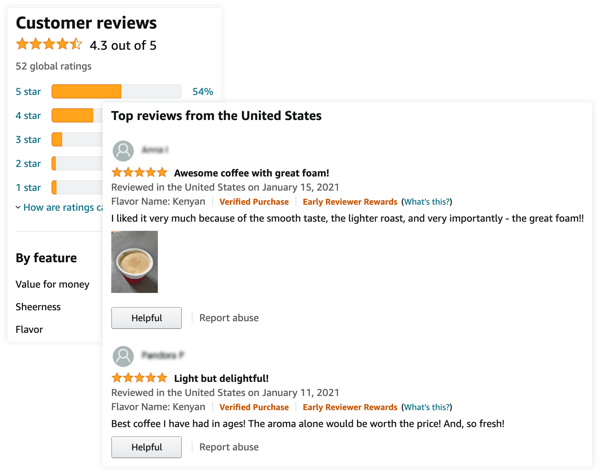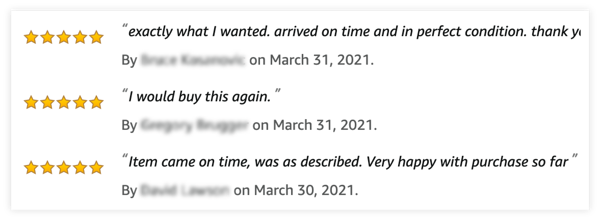Have you ever purchased a product online and the experience of receiving the product (shipping, customer service, etc.) proved to be difficult? On the other hand, have you ever received what you purchased and liked/disliked the actual product? The difference in experience comes down to seller feedback vs. product reviews—two very different yet incredibly valuable things on the Amazon marketplace.
To further separate products from sellers, Amazon offers shoppers the ability to rate both experiences—through customer/product reviews and third-party seller feedback. Unfortunately, Amazon makes it somewhat difficult to understand which is which and where you should leave what information. This leads to many customers leaving their feedback in the wrong location. For sellers, it can be hard to find the feedback they need to continue improving their business. And for products, it’s difficult for prospective customers to understand the product when reviews pertain to the seller experience.
To help you easily decipher the two, we’ll uncover the difference between product reviews and seller feedback, and discuss recent changes to both of these Amazon customer feedback systems:

Many people have, at one point in time, written a review for a product. To specify, product reviews on Amazon are reviews of specific products that are sold on the marketplace. These reviews appear towards the bottom of a product listing—as seen below on Henry’s House of Coffee’s Kenyan Coffee ASIN (catch our success story here).

Most of these reviews are from customers who bought the product, although reviewers aren’t required to be Amazon purchasers. To ensure you’re looking at an authentic product review from a customer, Amazon marks these as “Verified Reviews.” Customer reviews relate to a specific product, and discuss factors such as product quality and whether it functions as advertised. These reviews appear on the product page along with a star rating—and then an average star rating is given to the product based on the number of reviews it has received.
Amazon is serious about the integrity of its product reviews. Sellers are not allowed to review their own products, leave negative reviews about competitors, or offer customers incentives to leave positive reviews. Such practices can get a seller banned from Amazon. Some companies like FeedbackWhiz offer Amazon review services, which can help sellers gain more positive feedback while staying within Amazon’s guidelines.
Product reviews are incredibly important—57% of Amazon shoppers listed positive reviews as one of the most important purchase decision factors they consider. Sellers are always on the hunt for more positive reviews, but even the negative ones are a good source of information. They help sellers uncover patterns of issues that customers have—allowing brands to use this information to make changes to their Amazon listing(s), or help them learn how to enhance their product.
Shoppers are able to check a seller’s feedback and rating/score on their Amazon seller page—here’s SupplyKick’s as an example. To navigate to a seller's page, simply click on the “Sold by” on the right-hand side of the page on one of their product listings. We recommend checking a seller’s feedback score prior to purchasing as it helps the shopper determine whether or not the seller is legitimate. More on that below:
Amazon Seller Feedback
Looking to grow your seller reputation on Amazon? You’ve come to the right place. Seller feedback consists of comments not about the product itself, but about the buying and fulfillment experience. This includes whether it arrived on time, was delivered to the correct location, was packaged properly, and much more—and it also includes feedback about the seller’s customer service and returns experience.
You can receive this feedback regardless of whether you fulfill the order yourself (MFN or FBM) or if Amazon fulfills (FBA) the order. For FBA sellers, Amazon may reply to/omit feedback related to their fulfillment experience, providing this response below the review: Message from Amazon: This item was fulfilled by Amazon, and we take responsibility for this fulfillment experience.

Amazon customers are given a 90-day window from their order date to leave seller feedback. This feedback is also marketplace-specific, meaning if you sell on both Amazon US and Amazon Canada, seller feedback on one marketplace won’t affect the feedback/rating you receive on the other.
From the seller’s standpoint, Amazon Seller Feedback is an excellent metric to evaluate your performance on Amazon, as it gives clear insight from Amazon customers who purchase from retailers/wholesalers/resellers. Perhaps most significantly, a seller’s feedback score impacts their ability to win the Amazon Buy Box (the white box that invites the customer to “add to cart” on a product listing). 82% of all sales made on Amazon come from the Buy Box.
Amazon Seller Rating
Along with Seller Feedback, customers can also give a Seller Rating. It’s important to note that your Seller Feedback and Seller Rating are two different things (though they impact one another). While seller feedback is the review your buyer leaves about your services and/or your products—it’s inevitable they’ll leave product feedback here, too, because customers get confused—your seller rating measures your overall performance, trustworthiness, and success as a seller.

Sellers want to shoot for a positive rating of 95% or higher over the last 12 months—this is our recommendation and an industry standard, but Amazon does not specifically state this to our knowledge. When it comes to the star rating, 4-5 stars is considered positive, 3 is considered neutral, and 1-2 is considered negative. Sellers want to shoot for 4s and 5s from customers and do whatever they can (within the Amazon guidelines!) to combat ratings in the 1s, 2s, 3s.
The short answer is, not much, other than to avoid getting negative reviews/feedback in the first place—and by providing high quality products and a superior end-to-end customer experience. However, there are a few things Amazon sellers can do to take action against negative product reviews or seller feedback:
At one point, sellers could reply to negative product reviews right on the listing review page, and this reply could be viewed by other buyers perusing your product page. However, this is no longer allowed. In early 2021, Amazon changed its review policy to disable seller responses on product reviews, whether they are positive or negative. They also removed any existing seller replies and comments.
As for Seller Feedback, Amazon still allows sellers to publicly reply to feedback per their guidelines.
Amazon’s policy on product reviews and seller feedback has changed in the past and will most likely change in the future. While selling on the marketplace offers brands a chance to expand their reach and grow their sales, the landscape moves quickly and it’s difficult for many sellers to stay up-to-date.
A partnership with an Amazon seller consultant can help brands stay ahead of the curve and create a strategic communication plan with their customers. Along with building out an optimized Amazon marketing strategy, a good Amazon retailer or consultant helps promote your brand and increase your sales.
At SupplyKick, we make it our job to track Amazon’s frequent changes and ensure our partners are in compliance, while providing the best marketplace experience possible to their customers. Connect with us to learn how we can help you make the most of your Amazon presence.
Lorem ipsum dolor sit amet, consectetur adipiscing elit


Sign up to receive our newsletter for growth strategies, important updates, inventory and policy changes, and best practices.
These Stories on SupplyKick
For press inquiries, please contact Molly Horstmann, mhorstmann@supplykick.com